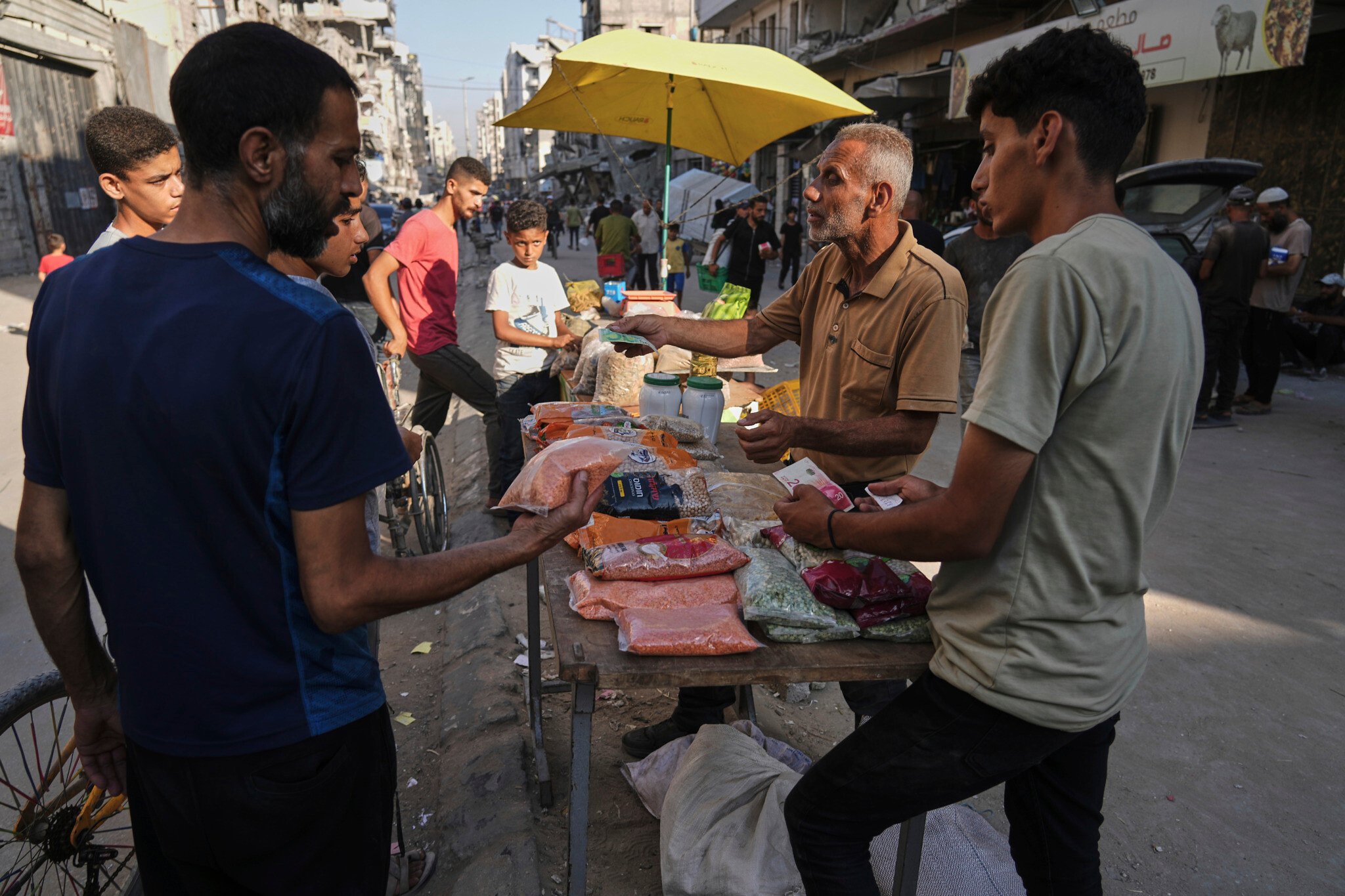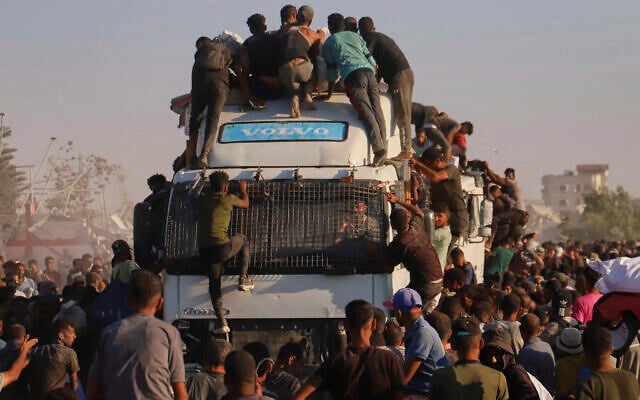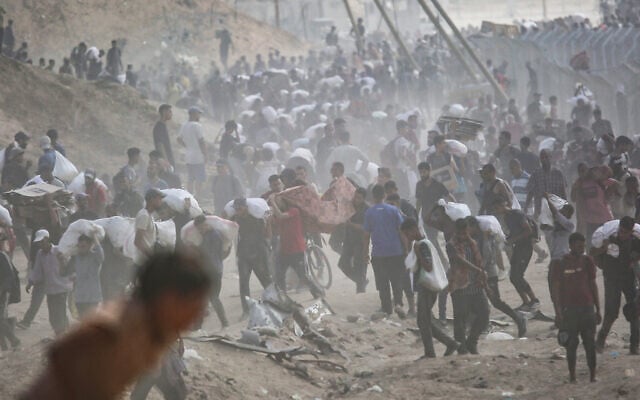For many Gazans, free aid from GHF sites or UN convoys have become a last resort

For over a month, Khaldun Hamad had refrained from heading toward the Zikim Crossing in northern Gaza to try to secure a bag of flour or other humanitarian aid.
It wasn’t that he didn’t need the food, but Hamad didn’t want to take the risk that came with making the trek some 10 kilometers northeast from his tent encampment.
The UN and other international organizations have been transporting trucks of aid from an IDF-guarded lot on the Gaza side of Zikim to warehouses and distribution sites elsewhere in the northern Strip.
But recent weeks have seen thousands of desperate Palestinians rushing the trucks shortly after they leave Zikim, climbing on top of the freight and frantically tearing open boxes to grab whatever food they can.
In the month of July, the overwhelming majority of UN aid was looted before it reached its intended destination. While aid has been trickling into Gaza over the past two months, the Israeli blockade that extended for the preceding 78 days brought food insecurity to dire levels, with many Palestinians too worried about finding their next meal to allow aid trucks to just pass by without stopping them.
The chaotic scenes near Zikim are similar to what unfolds at the three distribution sites operated by the Gaza Humanitarian Foundation (GHF) in southern and central Gaza, where thousands of Palestinians fling through entrance gates and ransack boxes of food that are emptied minutes after distribution begins each day.
Over half a million people in #Gaza are already enduring famine-like conditions.
WFP is doing everything possible to distribute vital food assistance to families.
To safely and consistently reach ALL those at risk of starvation, we need a ceasefire – NOW. pic.twitter.com/fpgPI2SL9C
— World Food Programme (@WFP) August 3, 2025
Weaker segments of the population most in need of aid are left empty-handed, while the strongest men win out — that is, if they make it there and back unscathed amid near-daily reports of the IDF opening fire on aid seekers.
The army contends that casualty numbers from such incidents reported by the Hamas-run health ministry are inflated, that it is sometimes Hamas operatives or other gunmen who are shooting at people trying to obtain aid, and that it only fires “warning shots” at those who pose a threat to troops.
Having heard many stories from family and friends about those killed or wounded trying to secure aid, 30-year-old Hamad has instead preferred purchasing aid from makeshift markets and street vendors. With Israel blocking almost all commercial goods from entering Gaza, much of what is sold is diverted aid, and costs have risen massively due to low supply and high demand.
Remarkable @nytimes graphic on soaring food prices in Gaza. Sugar is up by 11,810% from pre-war levels; flour, by 2,950%. Catastrophic for Gazans. And a reminder that Israel’s aid policy has (predictably) failed to achieve its own stated goal of eliminating the black market. ???? pic.twitter.com/ST9EDVdcsa
— Gregg Carlstrom (@glcarlstrom) August 1, 2025
To afford this food, Hamad and many other Gazans have started online fundraising campaigns that they have attached to their social media accounts.
But with the banking system in Gaza all but collapsed due to the war, those looking to deposit shekels must go through individuals Hamad characterized as “thieves” who have stockpiled cash and only agree to release it for commission rates as high as fifty percent.
Risking your life for a bag of flour
Hamad has lost roughly 13 kilograms (28 pounds) since the beginning of the war and has been eating between one and two meals a day for the past several months.
Last Thursday, the cost of purchasing food finally outweighed the relative safety of avoiding distribution sites for Hamad, and he set out for Zikim, determined to provide food for his wife and mother, who was wounded by Israeli gunfire while sitting outside their tent earlier in the war.
“I walked for 10 kilometers in the scorching sun just to try and bring back a bag of flour,” Hamad recalled in a phone interview with The Times of Israel.
He reached a point near Zikim where a crowd of roughly 10,000 Palestinians had already gathered in anticipation of an aid convoy’s arrival.
Khaldun Hamad. (Courtesy)
Before the trucks even reached the throng, Hamad claimed Israeli soldiers began opening fire “directly at us.”
A young man standing several meters away from Hamad was shot in the chest and crumbled to the ground.
The wounded man tugged at Hamad’s arm, begging him to save him and bring him to a hospital.
While exhausted and desperate to try to retrieve some aid, Hamad and another friend agreed to help, carrying the man for about a mile until they flagged down a tuk-tuk driver who agreed to finish the evacuation for NIS 100 ($29).
لحظات مرعبة إطلاق النار على المواطنين في غزة أثناء محاولتهم الوصول الى المساعدات الأمريكية في مشهد يجسد الخطر الذي يلاحق الجوعى حتى في بحثهم عن لقمة نجاة pic.twitter.com/Go0kUMj1UT
— ألأحداث ألإيرانية بالعربية (@_iraninarabic) August 4, 2025
In response to a query on the matter, the IDF said its troops fired “warning shots” after troops “perceived a threat” and tried and disperse a crowd of thousands that had gathered near aid trucks in northern Gaza.
The IDF stressed that it did not fire into the gathering and that while the matter is still being probed, initial findings did not include an identification of any casualties as a result of IDF fire. A military source added that gunshots were also heard from within the crowd.
“The IDF attaches the utmost importance to the transfer of humanitarian aid to the Gaza Strip, works to enable and facilitate the transfer of aid in coordination with the international community, and certainly does not deliberately act against [those being served by] humanitarian aid trucks,” an IDF statement said.
Still determined to secure some aid, Hamad then went back to his original destination near Zikim only to see the crowd stampeding toward four trucks that had arrived from the crossing.
He tried to grab a bag of flour, but was knocked to the ground, as gunfire continued to ring out. The trucks pushed through the crowd, and one of them nearly ran over Hamad’s leg. When he stood up, the convoy had passed, and everything he could see was covered in flour and dust.
Utterly dejected, Hamad walked back to his tent barefoot, having lost his shoes amid the havoc.

Palestinians ride on a truck loaded with food and humanitarian aid as it moves along the Morag corridor near Rafah, in the southern Gaza Strip, August 4, 2025. (AP/ Mariam Dagga)
“My eyes were drowning in tears — not because of the flour, but because of the humiliation,” he said. “Could you imagine risking your life like this just for a bag of flour?”
Still desperate, Hamad went back toward the Zikim Crossing the next day. This time, he encountered a man who had already secured a large bag of flour but was having a hard time carrying it and agreed to share a portion if Hamad agreed to help.
Hamad made it home again. This time, with some flour.
Gaza’s influencers
Unlike Hamad, Abdullah lives within relatively easy walking distance of the GHF distribution sites.
However, similar safety concerns have kept him away from the free boxes of food. Abdullah — who requested that his real name not be publicized in Israeli media due to fears for his safety — said his cousin had been killed while trying to reach a GHF site in June.
Accordingly, the 19-year-old has worked to come up with enough money to cover food costs and commission by setting up a TikTok account documenting his life in Gaza. He has amassed tens of thousands of followers, many of whom have donated through the link in his bio. It’s a strategy that has been adopted by many others in the enclave, where becoming an influencer is one of the few remaining occupations.
“For now, I’ve been able to help provide some money for my parents and three siblings, so that we don’t have to risk our lives at those ‘death traps,’” Abdullah said, referring to the GHF distribution centers.

Displaced Palestinians carry food parcels and supplies from a GHF aid distribution point in central Gaza, August 4, 2025. (Ali Hassan/Flash90)
GHF insists that its sites are safe and boasts having distributed over 100 million meals since it began operating in late May. But that figure is counted by adding up the caloric value of the various dried food products inside the handed out boxes, which require cooking fuel, equipment and potable water — all extremely scarce in the war-torn Strip.
The conversation with Abdullah was cut short after the wifi went down at a cafe near the Mawasi coastal zone, where he spends much of his days because cell service elsewhere is not as strong.
‘We’re some of the lucky ones’
Like Abdullah, Reef also lives in southern Gaza closer to GHF sites, and he did make the trek to them twice in June from an apartment that he and his father are sharing with another displaced family in Khan Younis.
Both times, the 27-year-old was unable to beat out the thousands of others who had headed to the site, and he returned home with nothing.
For the time being, he and his father have been able to pay for food, rather than relying on humanitarian aid.
“But we’re some of the lucky ones,” Reef said, expressing hope for a ceasefire and explaining that the aid situation stabilized during the previous truce, when several hundred trucks entered Gaza each day for distribution at hundreds of sites — most of which are no longer operational amid the gradual breakdown of law and order in the Strip.

Aid pallets are dropped from a military plane over Nuseirat in the central Gaza Strip during an airdrop mission on August 4, 2025. (AFP)
Reef too declined to publicize his last name due to what he said were safety concerns.
Hamad had a different approach and insisted on speaking on the record.
“I don’t want to die in silence. I want the people [to] know [about] our suffering. I want to feel that there [is] some humanity in this world [and that] there are people who do not support collective punishment,” he said.
The phone interview was held shortly after the Hamas terror group released a video of Evyatar David, showing the Israeli hostage emaciated and forced to dig what could become his own grave.
Asked for his reaction to the clip, Hamad responded: “I feel sorry for him and sorry for us. We don’t want them to suffer, and we don’t want to suffer ourselves.”
Israeli officials retort that David and the other hostages are being intentionally starved by their captors, whereas Jerusalem is allowing aid to enter the Strip, and Hamas diverts the aid from civilians. They point out that other adults in Gaza have typically lost far less weight than David has.
Disputing that framing, Hamad insisted that “Gaza is also being starved.”

